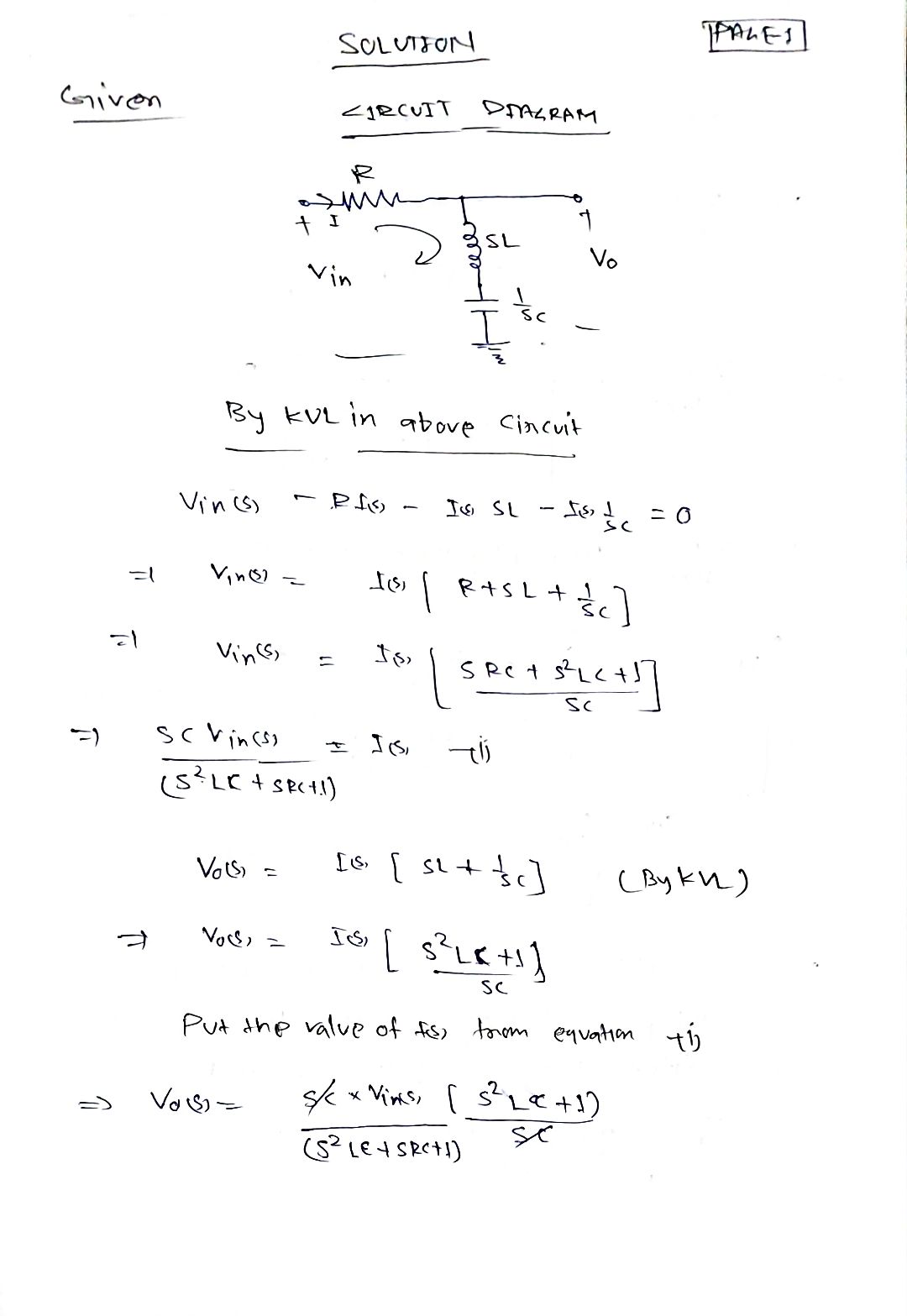1) The canonica nonical form for a band-reject filter is 2 sa wa + Wo O S² + BS a) Show that a m Hi band - reject filter : R un 3$L 2 + w₂² series RLC is a Š V/SC O b) Express bandwidth, center frequency and Quality Factor in terms of R, L,C. c) Determine the magnitude gain | Ht (jw)|
1) The canonica nonical form for a band-reject filter is 2 sa wa + Wo O S² + BS a) Show that a m Hi band - reject filter : R un 3$L 2 + w₂² series RLC is a Š V/SC O b) Express bandwidth, center frequency and Quality Factor in terms of R, L,C. c) Determine the magnitude gain | Ht (jw)|
Introductory Circuit Analysis (13th Edition)
13th Edition
ISBN:9780133923605
Author:Robert L. Boylestad
Publisher:Robert L. Boylestad
Chapter1: Introduction
Section: Chapter Questions
Problem 1P: Visit your local library (at school or home) and describe the extent to which it provides literature...
Related questions
Question
100%
1) Please solve with work, explanation would be great. Using to study. Will upvote!
![**Transcription:**
1) The canonical form for a band-reject filter is
\[
\frac{s^2 + \omega_0^2}{s^2 + \beta s + \omega_0^2}
\]
a) Show that a series RLC is a band-reject filter:
A circuit diagram is shown with the following components:
- A series combination of a resistor (R), an inductor (3L), and a capacitor (1/3C) arranged horizontally.
- There are two nodes: the input node and the output node.
- The circuit depicts a traditional RLC series network.
b) Express bandwidth, center frequency, and quality factor in terms of R, L, C.
c) Determine the magnitude gain \(|H(j\omega)|\).
**Explanation of Diagram:**
The diagram illustrates a series RLC circuit which includes:
- **Resistor (R):** Placed horizontally on one side.
- **Inductor (3L):** Placed in the middle of the series path.
- **Capacitor (1/3C):** Also in the series path, connected horizontally.
This configuration is typically used to create a band-reject or notch filter, which attenuates a specific range of frequencies and allows others to pass through.](/v2/_next/image?url=https%3A%2F%2Fcontent.bartleby.com%2Fqna-images%2Fquestion%2F93e18a88-13ba-47d2-8c84-ec9d29397d2a%2Fd84e8bc8-6c38-4568-9c14-03d31f58fae3%2Ffxygvg_processed.jpeg&w=3840&q=75)
Transcribed Image Text:**Transcription:**
1) The canonical form for a band-reject filter is
\[
\frac{s^2 + \omega_0^2}{s^2 + \beta s + \omega_0^2}
\]
a) Show that a series RLC is a band-reject filter:
A circuit diagram is shown with the following components:
- A series combination of a resistor (R), an inductor (3L), and a capacitor (1/3C) arranged horizontally.
- There are two nodes: the input node and the output node.
- The circuit depicts a traditional RLC series network.
b) Express bandwidth, center frequency, and quality factor in terms of R, L, C.
c) Determine the magnitude gain \(|H(j\omega)|\).
**Explanation of Diagram:**
The diagram illustrates a series RLC circuit which includes:
- **Resistor (R):** Placed horizontally on one side.
- **Inductor (3L):** Placed in the middle of the series path.
- **Capacitor (1/3C):** Also in the series path, connected horizontally.
This configuration is typically used to create a band-reject or notch filter, which attenuates a specific range of frequencies and allows others to pass through.
Expert Solution
Step 1

Step by step
Solved in 4 steps with 4 images

Knowledge Booster
Learn more about
Need a deep-dive on the concept behind this application? Look no further. Learn more about this topic, electrical-engineering and related others by exploring similar questions and additional content below.Recommended textbooks for you

Introductory Circuit Analysis (13th Edition)
Electrical Engineering
ISBN:
9780133923605
Author:
Robert L. Boylestad
Publisher:
PEARSON

Delmar's Standard Textbook Of Electricity
Electrical Engineering
ISBN:
9781337900348
Author:
Stephen L. Herman
Publisher:
Cengage Learning

Programmable Logic Controllers
Electrical Engineering
ISBN:
9780073373843
Author:
Frank D. Petruzella
Publisher:
McGraw-Hill Education

Introductory Circuit Analysis (13th Edition)
Electrical Engineering
ISBN:
9780133923605
Author:
Robert L. Boylestad
Publisher:
PEARSON

Delmar's Standard Textbook Of Electricity
Electrical Engineering
ISBN:
9781337900348
Author:
Stephen L. Herman
Publisher:
Cengage Learning

Programmable Logic Controllers
Electrical Engineering
ISBN:
9780073373843
Author:
Frank D. Petruzella
Publisher:
McGraw-Hill Education

Fundamentals of Electric Circuits
Electrical Engineering
ISBN:
9780078028229
Author:
Charles K Alexander, Matthew Sadiku
Publisher:
McGraw-Hill Education

Electric Circuits. (11th Edition)
Electrical Engineering
ISBN:
9780134746968
Author:
James W. Nilsson, Susan Riedel
Publisher:
PEARSON

Engineering Electromagnetics
Electrical Engineering
ISBN:
9780078028151
Author:
Hayt, William H. (william Hart), Jr, BUCK, John A.
Publisher:
Mcgraw-hill Education,